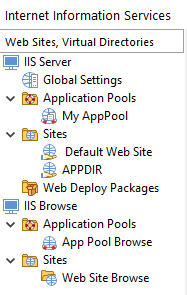
Optimizing Your Web Services with Microsoft's IIS - A Comprehensive Guide

Optimizing Your Web Services with Microsoft’s IIS - A Comprehensive Guide
Table of Contents
- Introduction
- Registration
- Using Advanced Installer
- GUI
- Working with Projects
- Installer Project
* Product Information
* Resources
* Package Definition
* Requirements
* User Interface
* System Changes
* Server
* Internet Information Services Page”)
* IIS Server
* Global Settings
* Website Settings
* Physical Path Credentials Dialog
* Web Site Bindings/SSL Settings
* Virtual Directory Settings
* ASP.NET Settings
* Access Flags
* Authentication
* Default Document
* Website Performance
* FTP Access
* FastCGI Settings
* ISAPI Filters
* MIME Types
* Application Mapping
* HTTP Response Headers
* Machine Key
* HTTP Error Handling
* .NET Error Handling
* Custom Properties
* Application Pools
* Web Deploy Packages
* Legacy Options
* IIS Browse
* ODBC
* SQL Databases
* SharePoint Page
* Silverlight Page
* Custom Behavior - Patch Project
- Merge Module Project
- Updates Configuration Project
- Windows Store App Project
- Modification Package Project
- Optional Package Project
- Windows Mobile CAB Projects
- Visual Studio Extension Project
- Software Installer Wizards - Advanced Installer
- Visual Studio integration
- Alternative to AdminStudio/Wise
- Replace Wise
- Migrating from Visual Studio Installer
- Keyboard Shortcuts
- Shell Integration
- Command Line
- Advanced Installer PowerShell Automation Interfaces
- Features and Functionality
- Tutorials
- Samples
- How-tos
- FAQs
- Windows Installer
- Deployment Technologies
- IT Pro
- MSIX
- Video Tutorials
- Advanced Installer Blog
- Table of Contents
Disclaimer: This post includes affiliate links
If you click on a link and make a purchase, I may receive a commission at no extra cost to you.
IIS Server
Install and configure Web Sites and Virtual Directories on an IIS Server or add Web Deploy Packages to be published on local (IIS) or remote/cloud targets. The IIS configuration tool helps you rapidly deploy web applications on Microsoft Windows servers family running Internet Information Services (versions 5.0 and above).

If you want to prevent a package containing IIS configurations from deploying on operating systems not listed above, use Software Launch Conditions Tab to set the proper install restrictions.
This Advanced Installer utility ensures a fast and uniform installation of your web applications on multiple servers, without having to worry about manually configuring the IIS on every machine through Microsoft Management Console.
Configuring The Global IIS Settings
In order to configure global IIS settings like: post install actions (backup metabase, open Microsoft Management Console for IIS), adding ISAPI filters or configure a global MIME map, select the “Global Settings” tree item from the left pane.
These options become available once you have added at least oneWeb Site or virtual directory .
Adding a new Application Pool
 Use the[New Application Pool ] toolbar button, the “New Application Pool” tree context menu item or press the* key while the “Web Sites, Virtual Directories” panel is focused.
Use the[New Application Pool ] toolbar button, the “New Application Pool” tree context menu item or press the* key while the “Web Sites, Virtual Directories” panel is focused.
Adding a new Web Site
 Use the [New Web Site ] toolbar button, the “New Web Site”tree context menu item or press theInsert key while the “Web Sites, Virtual Directories” panel is focused.
Use the [New Web Site ] toolbar button, the “New Web Site”tree context menu item or press theInsert key while the “Web Sites, Virtual Directories” panel is focused.
Adding a new Virtual Directory to a Web Site
 Use the[New Web Application ] toolbar button, the “New Web Application” tree context menu item or press the+ key while the “Web Sites, Virtual Directories” panel is focused.
Use the[New Web Application ] toolbar button, the “New Web Application” tree context menu item or press the+ key while the “Web Sites, Virtual Directories” panel is focused.
 Use the [New Virtual Directory ] toolbar button or the “New Virtual Directory” tree context menu item.
Use the [New Virtual Directory ] toolbar button or the “New Virtual Directory” tree context menu item.
You can create nested virtual directories by choosing “New Virtual Directory” when another virtual directory is selected in the tree. You can create as many child virtual directories as you like. A nested virtual directory “VDir_C” of the web site “MySite” can be addressed by the following URL:http://MySite/VDir\_A/VDir\_B/VDir\_C
Adding a new Web Deploy Package
 Use the [Add Web Deploy Package ] toolbar button or the “Add Web Deploy Package” tree context menu item.
Use the [Add Web Deploy Package ] toolbar button or the “Add Web Deploy Package” tree context menu item.
Renaming Web Sites or Virtual Directories
Use the “Rename” tree context menu item or press the F2 key while an element in the left-side tree control is selected.
Web Site names and Virtual Directory names are of Formatted Type and can contain Windows Installer property references, which will be resolved at install time.
Deleting Web Sites or Virtual Directories
 Use the [Delete ] toolbar button, the “Delete” tree context menu item, or press the Delete key while an element from the “Web Sites, Virtual Directories” panel is selected.
Use the [Delete ] toolbar button, the “Delete” tree context menu item, or press the Delete key while an element from the “Web Sites, Virtual Directories” panel is selected.
You can use the Browse IIS Advanced Installer functionality to enumerate existing Web Sites, Virtual Directories and Web Applications, as well as Application Pools on the IIS server.
You can configure any IIS entity by selecting the corresponding view from the Basic Settings top dropdown.
Topics
- Global Settings
Specify the global IIS settings. - Website Settings
Specify the Website settings of a new website on the target IIS Server. - Physical Path Credentials Dialog
Physical Path Credentials Dialog for IIS Web Sites - Web Site Bindings/SSL Settings
Configure HTTP and HTTPS/SSL settings for a Web Site. - Virtual Directory Settings
Specify the Virtual Directory settings. - ASP.NET Settings
Specify the ASP.NET settings. - Access Flags
Specify the Access Permission Flags settings. - Authentication
Setting web access authorization. - Default Document
Configure a default document list for the web site or virtual directory. - Website Performance
Specify the Website settings on the IIS Server. - FTP Access
Configure FTP access to your Web Site or Virtual Directory. - FastCGI Settings
Configure FastCGI application pool definitions. - ISAPI Filters
Manage ISAPI filters. - MIME Types
Configure the MIME types for the Web Site, Virtual Directory or the entire IIS web server. - Application Mapping
Settings for web application mappings. - HTTP Response Headers
Settings for HTTP Response Headers. - Machine Key
Specify the Machine Key settings. - HTTP Error Handling
Settings for HTTP Error Pages. - .NET Error Handling
Settings for .NET Error Pages. - Custom Properties
Set IIS properties for your website/virtual directory/application pool. - Application Pools
IIS Application Pools Configuration. - Web Deploy Packages
Add Web Deploy Packages - Legacy Options
Configure legacy options for IIS 5 or 6.
Did you find this page useful?
Please give it a rating:
Thanks!
Report a problem on this page
Information is incorrect or missing
Information is unclear or confusing
Something else
Can you tell us what’s wrong?
Send message
Also read:
- [New] Instrumental Integration Elevating Your Facebook Video Experience for 2024
- Best Video Repair tool to Fix and Repair Corrupted video files of Reno 11 Pro 5G
- Can You Recover Deleted Text Messages From an iCloud Backup? A Comprehensive Guide
- Comment Installer Et Utiliser Un Pilote De Repair Disk Pour Windows V7, 8, 10 Ou 11
- From Silence to Soundscape Step-by-Step in Audition for 2024
- In 2024, Churning Up Channels Top Gear List
- In 2024, Resolve Your iPhone 14 Pro Max Keeps Asking for Outlook Password | Dr.fone
- In 2024, The 6 Best SIM Unlock Services That Actually Work On Your Realme Device
- Las Topas Técnicas: Cómo Hacer Que Tu Fotografía Se Almacene en Dropbox Sin Esfuerzo
- Step-by-Step Guide: Starting Your Journey as a Prompt Engineer
- Story 1: The Misunderstanding of Esophageal Involvement
- Unveiling Truths About Facebook’s Popularity Claims
- Windows Server Incremental Backup Using WBAdmin and GUI Method
- Title: Optimizing Your Web Services with Microsoft's IIS - A Comprehensive Guide
- Author: Robert
- Created at : 2024-10-15 07:26:58
- Updated at : 2024-10-17 00:20:47
- Link: https://fox-triigers.techidaily.com/optimizing-your-web-services-with-microsofts-iis-a-comprehensive-guide/
- License: This work is licensed under CC BY-NC-SA 4.0.